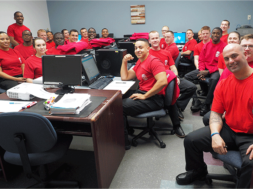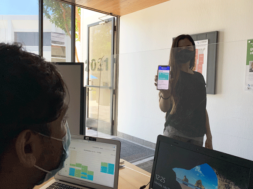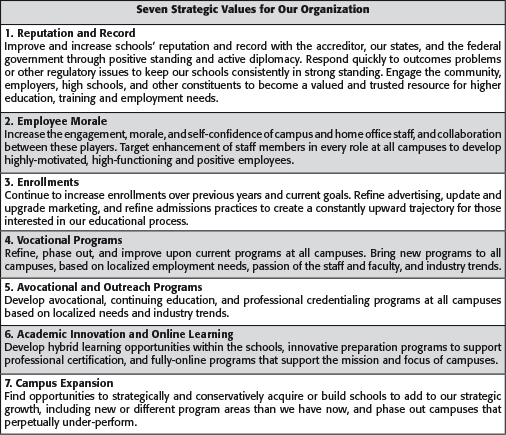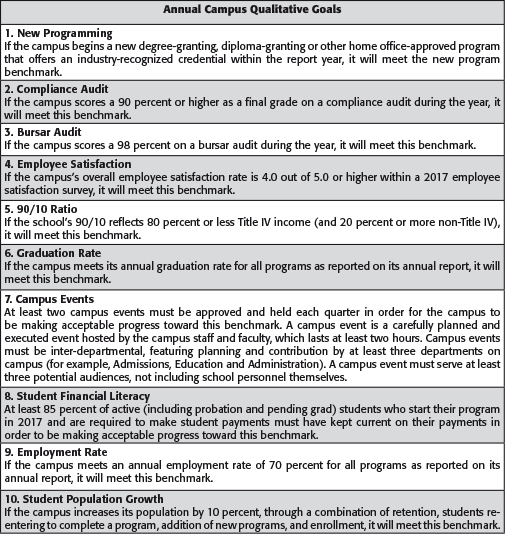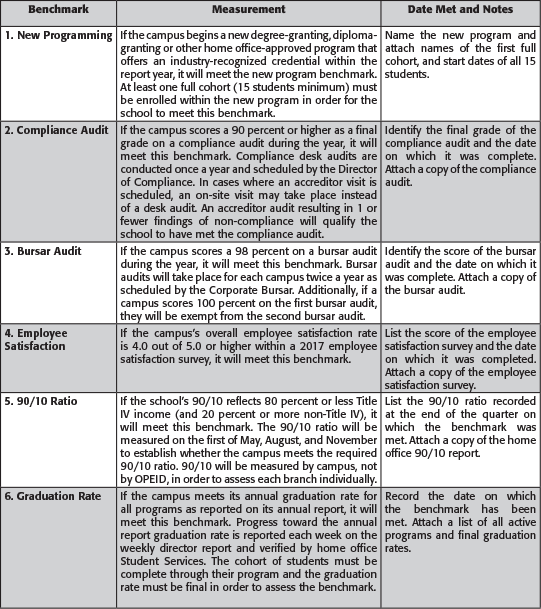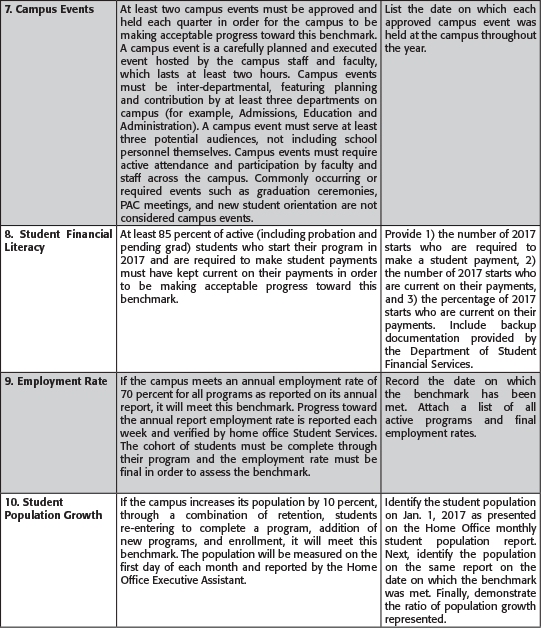
Competition Among Superheroes: Qualitative Assessment of Schools Within a Multi-Campus Group
By Dr. Joel A. English, Vice President of Operations, Centura College, Aviation Institute of Maintenance, Tidewater Tech
I love good campus directors. Whether we refer to them as campus presidents, executive directors, chancellors, or some other top dog moniker, those of us who work in multi-campus operations rely on our campus directors to carry out the executive vision, goals, and objectives at the local level. Our best campus directors do that with a firm understanding of home office values and with a style and leadership persona that translates our centralized goals into harmonious campus-level swagger.
Obviously, campus directors don’t do it alone, but their vision and leadership style, when done well, provides vision and motivation for faculty, staff and students, and creates a clear pathway for success within the entire campus community.
I believe that a good campus director can lead a campus to bending steel bars with their bare hands – if bare-handed bar bending is a meaningful goal that supports student success and institutional growth, and if that goal is expressed as an expected outcome with guidelines and timelines by which it is to be accomplished.
And that’s the job of the home office leader: setting clear goals for our campuses. Those of us who administer either an individual aspect of a multi-campus group of schools – Admissions, Academics, Student Affairs, etc. – and those of us who coordinate the work of the entire operational team of a school group set our campuses up for success when we 1) clearly define for the entire community our values and strategic vision, 2) build clearly-defined goals for our staff that are based on those values, 3) give precise benchmarks by which success toward those goals are defined, and 4) provide a timeline by which those successes will be measured. And if we can 5) sprinkle a little competition into the mix, all the better.
In our sector of education, we pride ourselves on our ability to make quick decisions and respond to industry and community needs efficiently. Every one of us has, at some point, enjoyed an edge over the local community college or university, because while they send good ideas into an Alice in Wonderland spiral of committee work, we leap into action and make good ideas a reality. Speed and agility is our strong point. But, when it comes to setting goals for our campuses, our “agility personality” can make it less natural for us to set clear long-range goals for our campuses and have the discipline to measure the same fundamental goals, quarter after quarter and year after year.
So, hat’s off to our ability to respond quickly to emerging needs.
But managing campus directors toward institutional goals takes forethought, design and reflection, as well as clear communication to the campus leaders about the goals they are working toward.
If you’d like to follow me into the next few pages, I’d like to share with you how we in our school group design and communicate the values, goals, assessment, timelines, and competition that lead our campuses to institutional success, and how this benchmarking structure supports our best campus directors in leaping tall buildings in single bounds.
1. Values: It starts with your institutional vision
I’m a Steve Jobs fan. I think that Steve’s three decades of innovation not only created some of the most impactful technologies of the past century, but his constant drive toward perfecting the user experience is what we should be doing in the career school sector. We know that prospective students have a choice in where they invest in their education, and it’s our job to make our student/user experience compellingly superior. There’s another thing that I love about Steve, which I try to emulate as a multi-campus executive: He annually communicated back to his constituents – Apple staff, users and shareholders – the shared vision and direction of his organization. Each year at the MacWorld conference, Jobs would recount to his stakeholders what makes their community tick, what their shared values were, and in that context, what the next year’s innovations would look like. His audience didn’t always like everything they heard (like the 1997 announcement that Apple would be working together with Microsoft to innovate the internet browsing experience), but the community always understood where the heart of their leadership was, and how individual directions connected with that heart. Apple’s goals and directions did not come across as willy-nilly ideas that sprung from who-knows-where, but rather, they were articulated as meaningful enterprises that tie to the core of the company itself.
I feel that it is important that the top leadership regularly review the values of the organization. Especially when establishing annual budgets, refreshed goals, or benchmarks that will guide a next phase of life, starting with a review of strategic vision and values is essential. And if your institution has not recently revisited its own core values, it’s time to do so.
In November of each year, my leaders and I hold a campus director meeting on-site near our home office in Virginia Beach. I start that meeting with a review of our strategic values, and I review the accomplishments from the past year in the context of those values. Do we celebrate that the Norfolk campus held three blood drives that year, that the Orlando campus was the first campus to meet its graduate employment rates, and that the Las Vegas campus increased its population size by 17 percent this year? Of course we do. But we don’t celebrate individual accomplishments simply because they happened; we celebrate them because those successes achieve specific goals tied to our core values. Successes that improve upon who we are are what I herald during this meeting.
Our core values, which have not changed since the day I took the position of Vice President of Operations in 2015, are the following:
I don’t present these values because I feel they are the perfect set of directions for other schools to adopt, and I don’t assume that they are perfectly-worded or perfectly-ordered for anyone other than us. I present them because we have them, and I think it is essential that every institution be able to articulate what their vision is and what values make up that vision. I think that every executive should be able to state why they get up in the morning and how the tasks they prioritize fit in to the core direction of the institution.
Anything I require of a school and anything extra I pile onto the plate of a school director should tie back to one or more of our institutional values.
And importantly, the pre-determined goals with which I challenge our campuses all are born from these constant values that we share among our schools. As I go on to describe the annual goals for our campuses, it is essential to remember that every one of those goals spring forth from one or more of the core values of our institution.
2. Goals: Tactical objectives spring out of core values
It’s not too difficult to assess the quantitative success of a campus. We tend to ask questions like:
- Is the campus profitable this quarter?
- Is the campus more or less profitable than this time last year?
- How is the campus performing compared to budget?
- How has the campus financial performance trended over the past three years?
- Is the campus positively or negatively contributing to the financial success of the institution as a whole?
These are all slightly different ways to inquire about the quantitative success of a campus, and they naturally lead to a discussion about the campus director’s quantifiable productivity as the business leader of the campus. The data to inform these questions can come from just a few worksheets: a P&L, a budget and a year-to-year comparison. The process of evaluating a campus – and its director – quantitatively is relatively simple.
The process of evaluating a campus qualitatively can be more challenging. We could ask questions like, “Do I get many employee or student complaints from that campus?” or “What does my gut say when I talk to the campus director?” But to what extent do we really set ourselves up for authentic qualitative assessments about the activity and productivity of our campuses? Possibly the more important question is: If we took time to carefully structure qualitative expectations and assessments of our campuses, is it possible that this would lead to financial success more quickly? Over the past three years, our schools have experienced positive financial success within an industry that has been decidedly marked by its lack thereof, and I believe that this is partly because we have structured qualitative annual goals for the campuses that are firmly based on our core institutional values. Here’s what those goals look like for 2017.
Here again, I don’t provide our campus qualitative goals because I feel they are the perfect formula for every school system to adopt. Indeed, some of them may seem awkward or inapplicable to another institution. Others may seem so obvious that they might not feel appropriate to list on a designated list of goals. But whether an individual goal appears obvious (like graduation and employment rates), awkward (why do you measure student financial literacy in the number of students who make their monthly payments?) or revolutionary (wow, you guys found a way to codify community service at your campuses?), one thing is essential: Every qualitative goal I expect my campuses to meet is tied to at least one – sometimes several – of our core institutional values.
Though the values listed within our institutional vision have not changed year to year, the individual annual goals have shape-shifted to some extent, based on a slightly different focus from year to year. In 2016, for example, we separated our new programming goal into two separate goals: I expected both one new vocational program to be rolled out at each campus, and also one shorter avocational program to be launched. In 2017, I combined these goals into one “New Programming” goal, which could be accomplished by either a full vocational program or a shorter program. This gave me a chance to add another goal for 2017 in the form of the “Campus Event” goal, a new one for us that directs campuses to design ongoing localized community outreach efforts – which tie to our first institutional value of “Record and Reputation.”
For 2018, I plan to add a campus goal entitled “Legislature Hosting,” where I will challenge all campus directors to invite and host their governor, U.S. congressperson, or senator to campus, in order to share with their lawmakers how we support the success of our students (and their constituents). Though there is nothing magical about having exactly 10 campus goals each year, I have found that to be a digestible number for the campus directors and their staff, so I will choose one of the goals to cycle out for 2018. The point is that the qualitative goals are clearly defined, that they tie to the institution’s core values and that they can be objectively measured for success. Let’s take a look at how that measurement looks.
3. Assessment: The anatomy of a benchmark
This November, our campus directors will be expecting me to review with them the final results of our 2017 efforts toward our annual benchmarks. But there will be no surprises, because every campus director will already know exactly how they have progressed through the year, and they have participated in the objective analysis of whether they attained each goal. Well-crafted goals do not end in surprises because they are articulated with 1) the values in which they are founded, 2) the goals they are designed to attained and 3) the assessment methodology which will determine whether the goal has been achieved. Likewise, the campus directors will also expect me to provide a refreshed list of benchmarks for 2018, which may add or subtract one or two benchmarks, and possibly amend the wording from the previous year based on our experience in 2017.
What is essential here is that every goal is accompanied by its own assessment methodology. The way we assess a qualitative goal should be objective, pre-determined and discussed fully, so that the campus directors can take those goals back to their campus leadership, staff and faculty, and discuss how the goals will orient their work in the coming year.
What converts a goal into a benchmark is the clear articulation of what exactly needs to be done in order to declare that the goal has been met – no surprises.
For example, the first benchmark listed above, the “New Programming” benchmark, appears to be pretty clear. It states, “If the campus begins a new degree-granting, diploma-granting or other home office-approved program that offers an industry-recognized credential within the report year, it will meet the new program benchmark.” That seems straight-forward. Shouldn’t be any quibbles, right? But you’d be surprised where people might try to negotiate the words if the assessment methodology isn’t clearly defined. For example, what exactly does “begins” mean? Does beginning a new program mean they start developing a program idea? Does it mean they hire a staff member and begin the program application process? Does it mean the campus must actually enroll a student in order for the program to have begun? What size of cohort is required to justify that the program has begun? This is the type of forethought and design that must go into a goal in order for it to become a solid, objectively-measurable benchmark.
In our case, we define “begin” as an authentic launch of a new program, where a full cohort – defined as 15 students – enters the program, and we require the campus director to list those first 15 students with each student’s program start date to justify the beginning of that program. It may take a year or two for a program to become gestated through state licensing, accreditation, and enrollment processes for that program to successfully begin. But when a campus accomplishes it, they have demonstrated authentic success.
Another example is the “Campus Events” benchmark. Central to this benchmark is that the campus creates new outreach opportunities to the community, and do it as a campus collective where staff and faculty around the campus contribute to community service. Upon first reading this benchmark, campus directors quickly had thoughts such as, “Oh, you mean like our career fairs, where we link our graduates to employers?” Or, “Oh, everyone loves a graduation ceremony, we’ll just invite the community to attend.” But commonly-occurring school functions like career fairs, graduation ceremonies, nursing pinning ceremonies, or open houses don’t get to the heart of community outreach, and it was essential for us to build that into the assessment of this benchmark.
To that end, in the pre-determined assessment methodology of this benchmark, we specifically wrote in that the campus event must serve at least three audiences external to anyone currently involved with the school, and we built in that at least three departments must work together to design and launch the outreach event. In order to demonstrate that they have met the goal, the campus must provide a complete description of the event, including the name, date and location of the event, a summary of the goals and audiences for the event, a full description of how the school met community needs, and a list of the campus participants who administered the event. This type of open clarity assures that the campus is thinking broadly and earnestly about serving the community, and it also assures that the campus director is not surprised later about a campus event not being accepted as a valid “Campus Event.”
4. Timeline: The campus report card
I’ve mentioned this November campus director meeting enough times that it is quite clear that timing is important to our administration and assessment of campus benchmarks. All of the qualitative goals are considered “annual campus benchmarks.” We stop and measure the progress of all campuses quarterly, and at the end of our qualitative reporting year in November, we present the grand tally of benchmarks attained per campus. The tool we use to measure our annual benchmarks is called the “Campus Report Card.” The Campus Report Card clearly states each goal and corresponding measurement methodology, and it lists the backup documentation that should be provided to demonstrate that the goal has been attained. Let’s take a look at the Campus Report Card.
2017 Campus Report Card
In 2017, all campuses will be measured against 10 annual qualitative benchmarks. Additionally, In November of 2017, any school that has met all 10 benchmarks will be eligible to compete for School of the Year. In most cases, a home office staff person will measure and report on a benchmark below, and the Regional Directors of Operations will use this “Campus Report Card” to keep up with the progress of the campuses toward the 10 annual benchmarks. Backup documentation must be kept on file to demonstrate completion of each benchmark reported on this report card.
The Campus Report Card has a number of intentions. First and foremost, the tool is designed to clearly delineate the terms, definitions, and expectations of the annual qualitative goals. We all know and understand, for example, that new programs are a good idea and are central to our strategic vision. The Campus Report Card delineates exactly what success in new programming will look like, and will clarify for all parties how to attain and report upon that success. The wording of the Campus Report Card minimizes quibbling later about whether a goal was or was not met.
The Campus Report Card also provides a timeline by which annual goals are met. We stop and measure progress toward the annual benchmarks each quarter, and assumedly, each campus sees forward progress toward the annual goals each quarter of the year. When this is not happening for a campus, it provides a coaching opportunity for our home office regional directors when talking with the campus directors. (A campus having only attained two or three benchmarks by halfway through the year, for example, gets attention!) The Campus Report Card is a structured, objective tool by which the campus directors can talk to their staff about qualitative progress, and it is a tool by which the home office regional directors can coach the campus directors about outstanding success or noticeable sluggishness. The Campus Report Card keeps us all on the same page about the progress toward the qualitative goals of each campus.
5. Competition: Gamifying campus achievement
The qualitative benchmarks also inspire competition, innovation, and occasional ribbing among our campus leaders. We all know that a spirit of competitiveness is an important personality trait of good campus directors, and our quarterly benchmark reporting plays off of the competitive spirit among our leaders. It also provides something of a level playing field for campuses of different sizes. For example, our small school of about 170 students in Kansas City could probably never compete quantitatively against our large school of over 700 students in Atlanta; but qualitatively, Kansas City can hold its own! I don’t expect schools in a small Midwestern town or suburban area to be able to thrive financially like schools in large metropolitan areas, but I do expect the staff and faculty of smaller markets to be just as passionate about their institutions, just as engaged with their communities, and just as committed to goal-meeting excellence as our larger schools. When it comes to progress toward the annual benchmarks, the playing field is level, and any school can win.
If you read the fine print at the top of the Campus Report Card, you noticed some specific wording about competition. The top paragraph reads, “In November of 2017, any school that has met all 10 benchmarks will be eligible to compete for School of the Year.” As a leadership team, we certainly do not expect that every campus will meet all 10 benchmarks every year. In fact, less than 20 percent of the schools usually hit all 10. That’s okay. All of the benchmarks are all challenging, and not every campus is perfect.
Those schools that do hit all 10 benchmarks are truly exceptional, and the campus directors who lead their schools to a perfect score are treated as super heroes.
I go out of my way to ask those campus directors to guide the others with tips for success and mentor the progress of others. At the end of the reporting year, the campuses that met all 10 benchmarks are put in the running for School of the Year, which is finally determined by that ultimate quantitative measurement: profitability. The most financially successful campus that met all 10 qualitative benchmarks is named School of the Year, and that campus director gets a little more love.
Meanwhile, the Campus Report Card is also used to assess the campus director’s leadership within their annual review. The Campus Report Card easily translates into a grade by multiplying the number of attained benchmarks by 10. 10 benchmarks equate to a perfect 100 – that’s an A+ in my book. Nine benchmarks is a 90, and everyone should be happy with an A. An 80 is pretty good – that’s a B. Seven benchmarks is acceptable, even if a C is nothing to write home about. You can imagine how much love a D wins for the campus director. And five or fewer benchmarks earned in a year is considered a failure. We don’t like F’s.
Measuring qualitative goals through the benchmarks on the Campus Report Card has become a productive way for campus directors to lead their staff to success with our collective institutional values. Yes, it has also become a tool for us to evaluate the success or failure of our campus directors, and it has made a few conversations about failed administrations somewhat simpler since the benchmarks are objective measurements of success or failure and since there are never any surprises about whether or not benchmarks have been met. Benchmarking our campuses to achieve our institutional goals has become one of our most effective methods to inspire both clarity of vision and healthy competition among campuses. This assessment methodology has allowed our super men and wonder women to guide their campuses to impressive success in the past few years, which for many institutions have not been so super.
DR. JOEL ENGLISH is the Vice President for Operations of Centura College, Aviation Institute of Maintenance, and Tidewater Tech, where he supervises all operations over the 18 campuses across the country. Dr. English is the President of the Central State Private Education Network (CSPEN), and he served as a Commissioner for the Accrediting Commission of Career Schools and Colleges for six years and the Chair of ACCSC for two years, as well as chairing the Distance Education Committee. In previous positions, Dr. English served as the CEO of the Ohio Centers for Broadcasting, Illinois Centers for Broadcasting, and Miami Media School, a family of schools dedicated to technical education in radio, television and internet media broadcasting. He also oversaw distance learning and school operations at several campuses as a Regional Director and Executive Director at Centura College, and he was formerly an Assistant Professor of English and Distance Learning at Old Dominion University. Dr. English recently published Plugged In: Succeeding as an Online Learner through Wadsworth/Cengage Learning, as an extension of his dedication to supporting student success within online courses and programs. Dr. English holds a Ph.D. in Rhetoric and Composition from Ball State University and an M.A. and B.A. in Technical and Expository Writing from the University of Arkansas at Little Rock.
Contact Information: Dr. Joel A. English // Vice President of Operations // Centura College, Aviation Institute of Maintenance, and Tidewater Tech // jenglish@centura.edu




